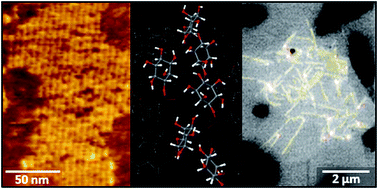Hierarchically patterned striped phases of polymerized lipids: toward controlled carbohydrate presentation at interfaces†
Abstract
Complex biomolecules, including carbohydrates, frequently have molecular surface footprints larger than those in broadly utilized standing phase alkanethiol self-assembled monolayers, yet would benefit from structured orientation and clustering interactions promoted by ordered monolayer lattices. Striped phase monolayers, in which alkyl chains extend across the substrate, have larger, more complex lattices: nm-wide stripes of headgroups with 0.5 or 1 nm lateral periodicity along the row, separated by wider (∼5 nm) stripes of exposed alkyl chains. These anisotropic interfacial patterns provide a potential route to controlled clustering of complex functional groups such as carbohydrates. Although the monolayers are not covalently bound to the substrate, assembly of functional alkanes containing an internal diyne allows such monolayers to be photopolymerized, increasing robustness. Here, we demonstrate that, with appropriate modifications, microcontact printing can be used to generate well-defined microscopic areas of striped phases of both single-chain and dual-chain amphiphiles (phospholipids), including one (phosphoinositol) with a carbohydrate in the headgroup. This approach generates hierarchical molecular-scale and microscale interfacial clustering of functional ligands, prototyping a strategy of potential relevance for glycobiology.

- This article is part of the themed collection: Nanolithography of biointerfaces


 Please wait while we load your content...
Please wait while we load your content...